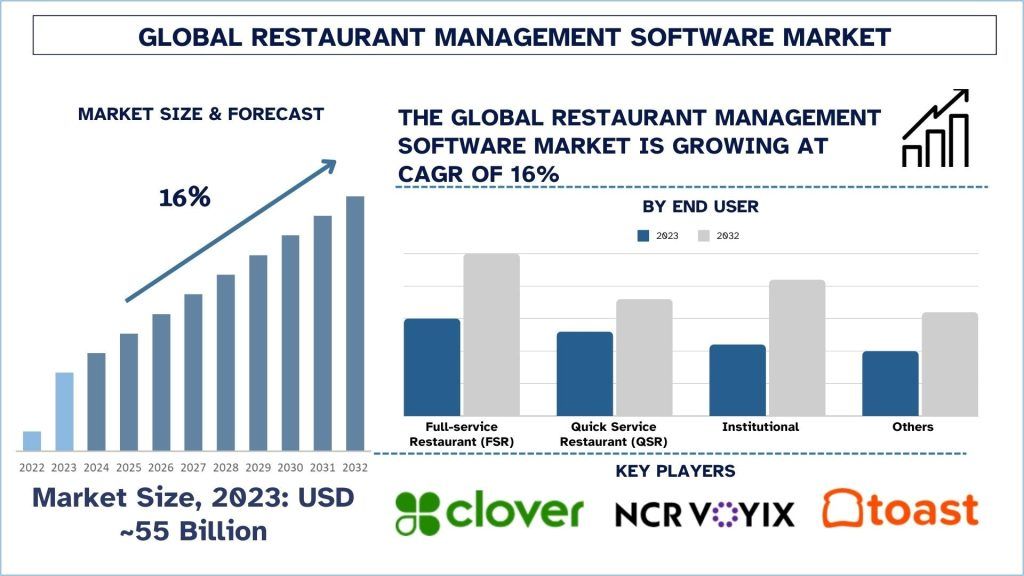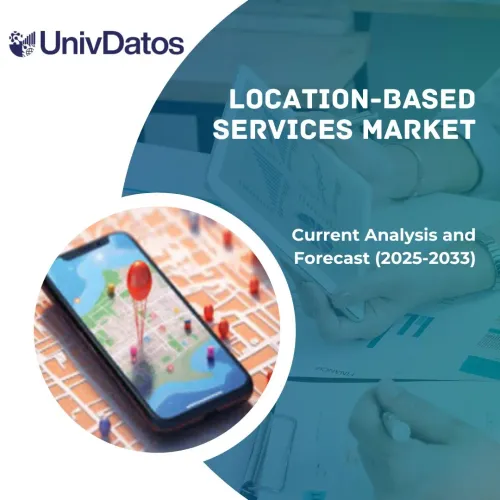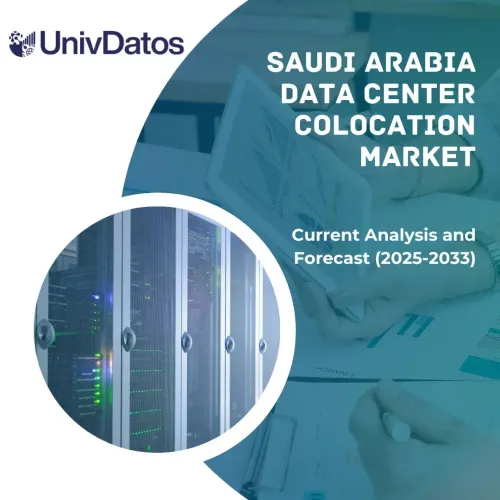- Home
- About Us
- Industry
- Services
- Reading
- Contact Us
Restaurant Management Software Market: Current Analysis and Forecast (2024-2032)
Emphasis on Software (Front-end Software, Accounting & Cash Flow, Purchasing & Inventory Management, Table & Delivery Management, Employee Payroll & Scheduling, Others); Deployment (Cloud, On-premise); End User (Full-service Restaurant (FSR), Quick Service Restaurant (QSR), Institutional, Others); and Region/Country
Restaurant Management Software Market Size & Forecast
The Restaurant Management Software market was valued at approximately USD 55 billion in 2023 and is expected to grow at a substantial CAGR of around 16% during the forecast period (2024-2032) owing to the increased adoption of technology and demand for contactless solutions.
Restaurant Management Software Market Analysis
Restaurant management software is designed to be an end-to-end software solution to help users run their restaurants. In addition, the increasing acceptance of new restaurant service technologies and demand for quick service restaurant services are driving the growth of the global restaurant management software market.
Moreover, the growing use of technology to manage operations in the restaurant sector is driving the global restaurant management software market. Furthermore, features including scheduling templates, in-app messaging, and multi-location team management, help restaurant staff more efficiently and better manage labor costs and help increase employee job satisfaction.
For instance, on September 12, 2023, Oracle introduced a new affordable, easy-to-deploy restaurant management platform offer to help independent restaurants increase sales, boost efficiency, and maximize profitability. Oracle Restaurants provides operators with proven Point of Sale (POS) hardware and software, payment processing, and online ordering capabilities all for one low price.
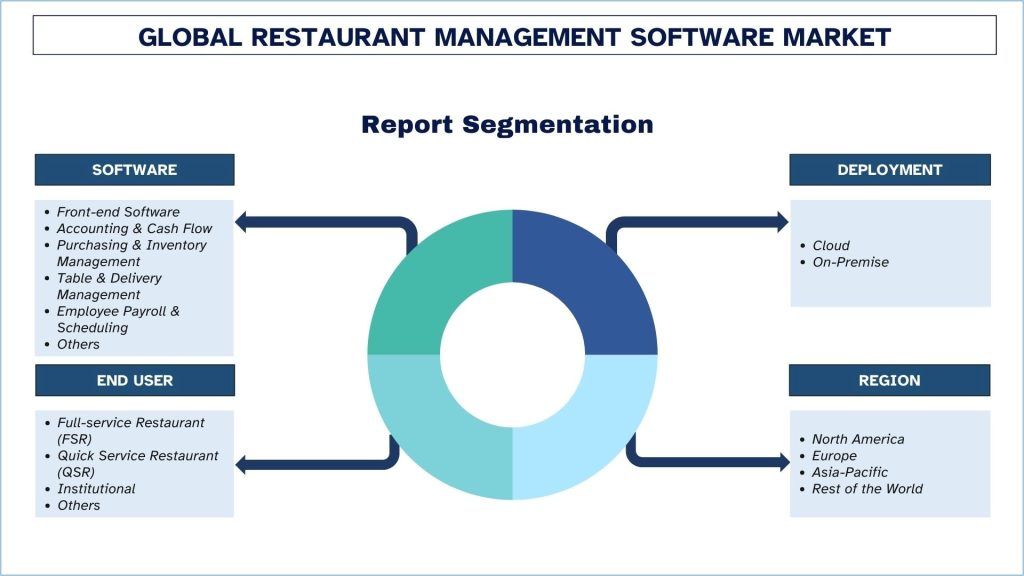
Restaurant Management Software Market Trends
This section discusses the key market trends influencing the various segments of the Restaurant Management Software market as identified by our research experts.
AI and Machine Learning Integration Transform the Restaurant Management Software Industry
AI & Machine learning in the Restaurant Management Software market are transforming the business environments and customers. These technologies help in carrying out predictive analysis for demand, supplies, and stocks and reduce wastage. Customers’ information is used in the marketing strategy, and the loyalty programs aimed at increasing customers’ interest are developed by machine learning algorithms that enhance customer interaction. With AI-enabled chatbots, real-time communication and order management make business an easy process. Furthermore, it helps in staff management because it analyzes when the flow of people is going to be highest so that more employees can be called ahead of time. With more restaurants focusing on data analysis to make their decisions, artificial intelligence, and machine learning have become almost mandatory.
For instance, in April 2024, Toast launched its Restaurant Management Suite with new features for multi-unit, enterprise brands. They add AI-Based Benchmarking Feature. These features join the company’s cloud-based digital technology platform that is built for restaurants of all sizes and is used in more than 100,000 restaurant locations.
North America led the market
This is mainly attributed to the rapid urbanization, rising disposable income, the well-organized character of the food service sector, and a high level of vendor market penetration all contribute to the regional industry’s growth. Therefore, Vendors are launching innovative software solutions such as payroll, staff scheduling, and inventory management to carry out back-end operations professionally. Further, increasing digitalization and advances in smart technology, such as automated point-of-sale systems, wireless payment methods, and virtual reservation systems in the sub-continent, are to be blamed for the market expansion in the region throughout the projection period.
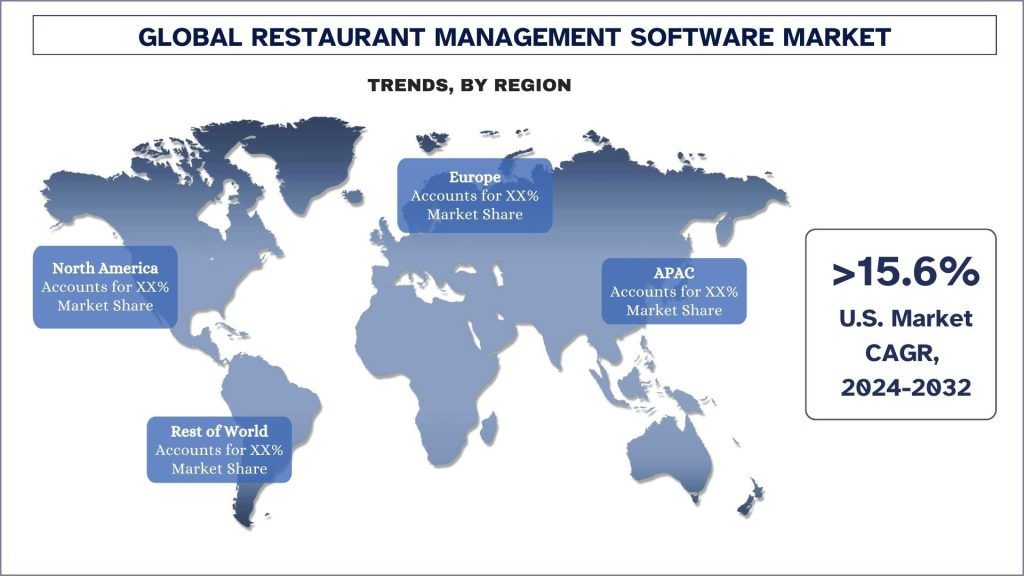
Restaurant Management Software Industry Overview
The Restaurant Management Software market is competitive, with several global and international players. The key players are adopting different growth strategies to enhance their market presence, such as partnerships, agreements, collaborations, new product launches, geographical expansions, and mergers and acquisitions. Some of the major players operating in the market are Clover Network, LLC; NCR VOYIX; Oracle; Revel Systems; TouchBistro; Toast, Inc.; 7shifts; OpenTable, Inc.; Jolt Software, Inc.; Block, Inc. (Square Capital, LLC).
Restaurant Management Software Market News
In January 2024 – Fantuan, a leading global Asian food delivery and life service platform, announced the acquisition of Chowbus’ delivery business. Following the acquisition, Chowbus will focus on developing and optimizing its restaurant Software-as-a-Service (SaaS) and Point of Sales (POS) business.
On May 20, 2024– NCR Voyix (NYSE: VYX), a leading global provider of digital commerce solutions, introduced Aloha Pay-At-Table, powered by sunday, to enhance the overall dining experience.
Restaurant Management Software Market Report Coverage
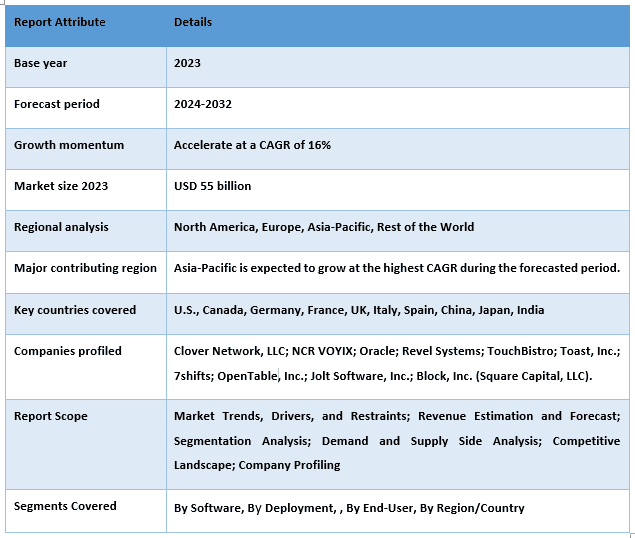
Reasons to buy this report:
- The study includes market sizing and forecasting analysis validated by authenticated key industry experts.
- The report presents a quick review of overall industry performance at one glance.
- The report covers an in-depth analysis of prominent industry peers with a primary focus on key business financials, product portfolios, expansion strategies, and recent developments.
- Detailed examination of drivers, restraints, key trends, and opportunities prevailing in the industry.
- The study comprehensively covers the market across different segments.
- Deep dive regional level analysis of the industry.
Customization Options:
The global Restaurant Management Software market can be customized further as per the requirement or any other market segment. Besides this, UMI understands that you may have your own business needs, hence feel free to connect with us to get a report that completely suits your requirements.
Table of Content
Research Methodology for the Restaurant Management Software Market Analysis (2022-2032)
Analyzing the historical market, estimating the current market, and forecasting the future market of the global Restaurant Management Software market were the three major steps undertaken to create and analyze the adoption of Restaurant Management Software in major regions globally. Exhaustive secondary research was conducted to collect the historical market numbers and estimate the current market size. Secondly, to validate these insights, numerous findings and assumptions were taken into consideration. Moreover, exhaustive primary interviews were also conducted, with industry experts across the value chain of the global Restaurant Management Software market. Post assumption and validation of market numbers through primary interviews, we employed a top-down/bottom-up approach to forecasting the complete market size. Thereafter, market breakdown and data triangulation methods were adopted to estimate and analyze the market size of segments and sub-segments of the industry. Detailed methodology is explained below:
Analysis of Historical Market Size
Step 1: In-Depth Study of Secondary Sources:
A detailed secondary study was conducted to obtain the historical market size of the Restaurant Management Software market through company internal sources such as annual reports & financial statements, performance presentations, press releases, etc., and external sources including journals, news & articles, government publications, competitor publications, sector reports, third-party database, and other credible publications.
Step 2: Market Segmentation:
After obtaining the historical market size of the Restaurant Management Software market, we conducted a detailed secondary analysis to gather historical market insights and share for different segments & sub-segments for major regions. Major segments are included in the report as software, deployment, end user, and regions. Further country-level analyses were conducted to evaluate the overall adoption of testing models in that region.
Step 3: Factor Analysis:
After acquiring the historical market size of different segments and sub-segments, we conducted a detailed factor analysis to estimate the current market size of the Restaurant Management Software market. Further, we conducted factor analysis using dependent and independent variables such as software, deployment, end user, and regions of the Restaurant Management Software market. A thorough analysis was conducted for demand and supply-side scenarios considering top partnerships, mergers and acquisitions, business expansion, and product launches in the Restaurant Management Software market sector across the globe.
Current Market Size Estimate & Forecast
Current Market Sizing: Based on actionable insights from the above 3 steps, we arrived at the current market size, key players in the global Restaurant Management Software market, and market shares of the segments. All the required percentage shares split and market breakdowns were determined using the above-mentioned secondary approach and were verified through primary interviews.
Estimation & Forecasting: For market estimation and forecast, weights were assigned to different factors including drivers & trends, restraints, and opportunities available for the stakeholders. After analyzing these factors, relevant forecasting techniques i.e., the top-down/bottom-up approach were applied to arrive at the market forecast for 2032 for different segments and sub-segments across the major markets globally. The research methodology adopted to estimate the market size encompasses:
The industry’s market size, in terms of revenue (USD) and the adoption rate of the Restaurant Management Software market across the major markets domestically
All percentage shares, splits, and breakdowns of market segments and sub-segments
Key players in the global Restaurant Management Software market in terms of products offered. Also, the growth strategies adopted by these players to compete in the fast-growing market
Market Size and Share Validation
Primary Research: In-depth interviews were conducted with the Key Opinion Leaders (KOLs) including Top Level Executives (CXO/VPs, Sales Head, Marketing Head, Operational Head, Regional Head, Country Head, etc.) across major regions. Primary research findings were then summarized, and statistical analysis was performed to prove the stated hypothesis. Inputs from primary research were consolidated with secondary findings, hence turning information into actionable insights.
Split of Primary Participants in Different Regions
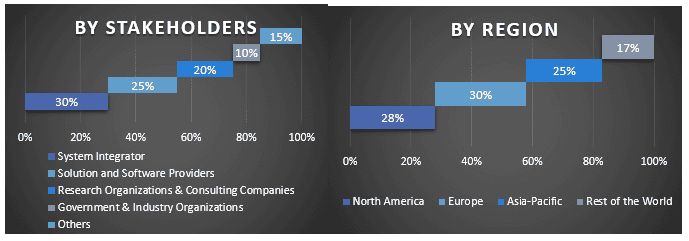
Market Engineering
The data triangulation technique was employed to complete the overall market estimation and to arrive at precise statistical numbers for each segment and sub-segment of the global Restaurant Management Software market. Data was split into several segments and sub-segments after studying various parameters and trends in the software, deployment, end user, and regions of the global Restaurant Management Software market.
The main objective of the Global Restaurant Management Software Market Study
The current & future market trends of the global Restaurant Management Software market were pinpointed in the study. Investors can gain strategic insights to base their discretion for investments on the qualitative and quantitative analysis performed in the study. Current and future market trends determined the overall attractiveness of the market at a regional level, providing a platform for the industrial participant to exploit the untapped market to benefit from a first-mover advantage. Other quantitative goals of the studies include:
- Analyze the current and forecast market size of the Restaurant Management Software market in terms of value (USD). Also, analyze the current and forecast market size of different segments and sub-segments.
- Segments in the study include areas of the software, deployment, end user, and regions.
- Define and analyze the regulatory framework for the Restaurant Management Software
- Analyze the value chain involved with the presence of various intermediaries, along with analyzing customer and competitor behaviors of the industry.
- Analyze the current and forecast market size of the Restaurant Management Software market for the major region.
- Major countries of regions studied in the report include Asia Pacific, Europe, North America, and the Rest of the World
- Company profiles of the Restaurant Management Software market and the growth strategies adopted by the market players to sustain the fast-growing market.
- Deep dive regional level analysis of the industry
Frequently Asked Questions FAQs
Q1: What is the Restaurant Management Software market's current size and growth potential?
Q2: What are the driving factors for the growth of the Restaurant Management Software market?
Q3: Which segment has the largest share of the Restaurant Management Software market by deployment?
Q4: What are the major trends in the Restaurant Management Software market?
Q5: Which region will dominate the Restaurant Management Software market?
Related Reports
Customers who bought this item also bought

